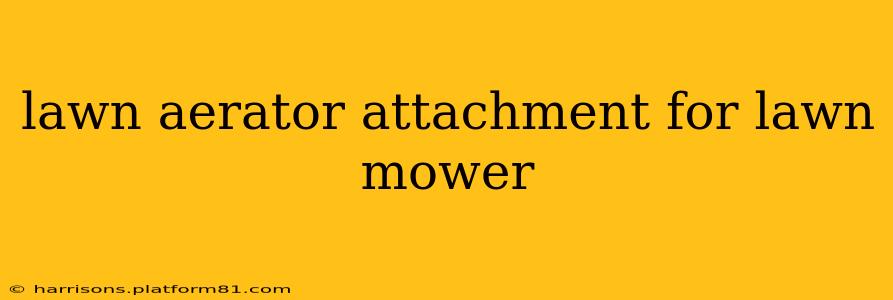Maintaining a healthy, vibrant lawn requires more than just mowing. Compacted soil can suffocate grass roots, leading to brown patches, weak growth, and increased susceptibility to disease. That's where a lawn aerator comes in. While standalone aerators are effective, attaching an aerator to your existing lawn mower offers convenience and efficiency. This guide explores lawn aerator attachments for lawn mowers, covering everything from types and benefits to selection and usage.
What is a Lawn Aerator Attachment?
A lawn aerator attachment is a device that fits onto your lawn mower, allowing you to aerate your lawn while mowing. These attachments typically use tines or spikes to puncture the soil, creating small holes that improve air, water, and nutrient penetration to the roots. This is a much more efficient process than using a standalone aerator, especially for larger lawns.
Types of Lawn Aerator Attachments
Several types of aerator attachments are available, each with its own advantages and disadvantages:
-
Tine Aerators: These are the most common type, using hollow tines to remove small plugs of soil. This is generally considered the most effective method for aeration, as it creates larger, more lasting holes.
-
Spike Aerators: These use solid metal spikes to pierce the soil. While less effective at removing soil plugs than tine aerators, they are often more affordable and easier to maintain. They're a good option for lighter aeration needs.
-
Slice Aerators: These use blades to slice into the soil, creating narrow slits. This method is less disruptive than tine aeration but still improves soil penetration.
Benefits of Using a Lawn Aerator Attachment
Using a lawn aerator attachment offers several significant benefits:
- Convenience: Combine aeration with mowing in a single pass, saving you time and effort.
- Efficiency: Cover a larger area quickly, making it ideal for larger lawns.
- Cost-effectiveness: Often cheaper than purchasing a standalone aerator, especially if you already own a lawn mower.
- Improved Lawn Health: Better air, water, and nutrient penetration lead to healthier, thicker, greener grass.
- Reduced Compaction: Regular aeration helps break up compacted soil, allowing roots to grow more deeply.
How to Choose the Right Lawn Aerator Attachment
Choosing the right attachment depends on several factors:
- Lawn Size: For larger lawns, a tine aerator might be more efficient despite the higher cost. Smaller lawns might benefit from the affordability of a spike aerator.
- Soil Type: Heavily compacted soil will benefit from a tine aerator to remove plugs. Lighter soil may only require spike aeration.
- Mower Compatibility: Ensure the attachment is compatible with your lawn mower's type and model. Check manufacturer specifications carefully.
- Budget: Spike aerators are generally cheaper than tine aerators.
How Often Should You Aerate Your Lawn?
The frequency of aeration depends on several factors, including soil type, grass type, and traffic levels. As a general guideline, most lawns benefit from aeration once or twice a year, preferably in spring or fall. Heavily compacted areas may require more frequent aeration.
Can I Use a Lawn Aerator Attachment on All Types of Mowers?
No, not all lawn mowers are compatible with aerator attachments. The compatibility will depend on the make and model of your mower and the type of aerator attachment. Always check the manufacturer's specifications before purchasing.
What is the Difference Between Aeration and Dethatching?
Aeration focuses on improving soil conditions by reducing compaction. Dethatching, on the other hand, removes the layer of dead grass (thatch) that can accumulate on the lawn's surface, inhibiting growth. While both improve lawn health, they address different issues and are often used in conjunction.
Are There Any Disadvantages to Using a Lawn Aerator Attachment?
While generally beneficial, using a lawn aerator attachment has some potential drawbacks:
- Potential for Damage: Improper use or incompatibility with your mower can damage your lawn or the equipment.
- Time Commitment: While faster than standalone aerators, it still requires time and effort.
- Limited Depth: Attachments may not aerate as deeply as standalone aerators.
Conclusion
A lawn aerator attachment can be a valuable tool for improving your lawn's health and appearance. By understanding the different types of attachments, their benefits and drawbacks, and proper usage, you can choose the best option for your lawn and ensure a lush, vibrant, and healthy landscape. Remember to always follow the manufacturer's instructions and prioritize safety when using any lawn care equipment.
